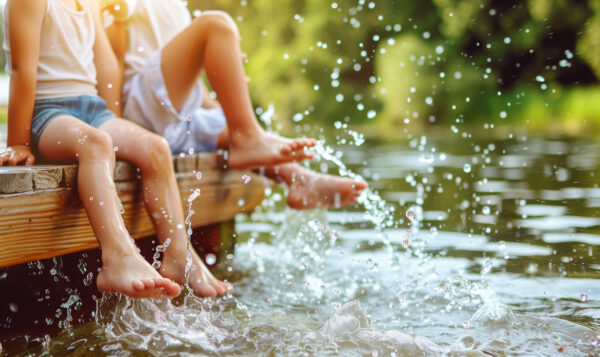
Have You Considered Hydro-raking as an Aquatic Management Tool?
Written by Industry Expert Emily Walsh, Environmental Scientist
If you own or manage a lake or pond, you’ve likely heard of hydro-raking as a unique management tool utilized by aquatic professionals to remove aquatic vegetation. A hydro-rake is essentially a floating barge supporting a mounted backhoe and rake attachment that can remove up to 500 pounds of lake and pond muck, aquatic plant material and organic debris in a single scoop.
The hydro-rake has the ability to target certain areas of nuisance and/or invasive aquatic vegetation, while conserving other areas in their natural state. This is crucial in the eyes of aquatic management, which is geared towards retaining and restoring balance within the waterbody’s ecosystem. Maintaining an equilibrium of native vegetation enhances the potential for increased species richness and ecosystem resilience – the ability to maintain balance despite challenges posed by nutrient loading, water stratification and other factors that can affect water quality. In addition to proactively managing vegetation, hydro-raking can help reduce or prolong the need for dredging, which is often the costliest project a homeowners association will ever face.

Can hydro-raking be an annual management service?
While the hydro-rake is not a suitable management strategy in every situation, it can be extremely effective when used to control several types of vegetation often found in waterbodies used for recreation, community fishing, the collection of stormwater runoff, or simply the enjoyment of their aesthetic beauty:

Emergent Species
Emergent vegetation such as cattails, common reed (phragmites) and maidencane are common plants that can plague waterbodies; however, removal can be achieved by utilizing the hydro-rake as a stand-alone management option or as a complement to other management approaches. Emergent plants are fantastic candidates for the hydro-rake because they are usually found along the edge of the waterbody, where they can be easily accessed by the rake attachment. During the removal process, the hydro-rake will extract the plant in its entirety, as well as its attached rhizome (root) structure lain beneath the water’s surface. Because the hydro-rake works from the water rather than land, desirable ornamental and beneficial vegetative buffer plant species along the shoreline are not impacted.

Floating Leaf Species
The hydro-rake is effective when removing common floating leaf vegetation such as water lily and watershield. These plant species are ideal for hydro-rake management, due to their leaf structure and attached root systems underneath. As with common reed and cattail removal, the hydro-rake can remove the plants, as well as the root structures. Open water is then restored, thus enhancing the ability of native aquatic flora and fauna to repopulate the area. Other common floating-leaf species, such as water hyacinth, water chestnut, and water lotus are additional candidates for hydro-raking service

Submersed Species
Submersed species such as curly-leaf pondweed, big leaf pondweed and tape grass can be effectively managed through hydro-raking. These prescribed programs can provide sufficient plant reduction, especially when combined with herbicide management options. As with any management strategy, it’s important to always consider the biology of the targeted plant before beginning a hydro-raking project. Some submersed plants, such as such as milfoil and fanwort spread heavily through fragmentation and may require alternate management strategies to ensure fragmentation and re-population do not occur.
Hydro-raking is a management tool used in a wide array of aquatic restoration projects ranging from inlets, outlets, littoral zones, coves, private shorelines, and more. Aquatic vegetation removal projects can be performed any time of year, but the best time is when the nutrients are in the vegetative structure; this is relative to the associated region, weather conditions and plant biology. When considering this service, the first step is to contact your local lake and pond management professional to conduct a site visit. During this time, they will identify nuisance plant species and management areas, and consider a strategy that aligns with your long-term waterbody goals.
As with any form of proactive management, hydro-raking can help improve the health, longevity and beauty of your lake or pond for years to come, but is most effective when used in conjunction with other preventative management methods, including aeration, buffer management, nutrient remediation and other strategies that prevent the premature aging, or filling in with sediment, of the waterbody.
Check Out the Hydro-Rake in Action!
SOLitude Lake Management is an environmental firm committed to providing full-service solutions that improve water quality, preserve natural resources, and reduce our environmental footprint. Our services include lake, pond, wetland and fisheries management programs, algae and aquatic weed control, mechanical harvesting, hydro-raking, installation and maintenance of fountains and aeration systems, water quality testing and restoration, bathymetry, lake vegetation studies, biological assessments, habitat assessments, invasive species management and nuisance wildlife management. Services, consulting and aquatic products are available to clients nationwide, including homeowners associations, multi-family and apartment communities, golf courses, commercial developments, ranches, private landowners, reservoirs, recreational and public lakes, municipalities, parks, and state and federal agencies. Learn more about SOLitude Lake Management and purchase products at www.solitudelakemanagement.com.









